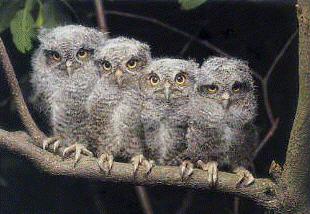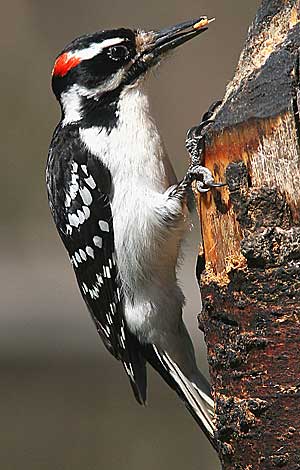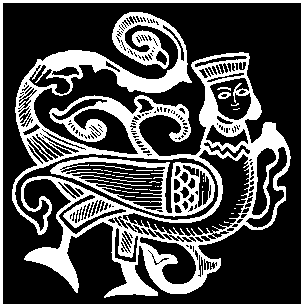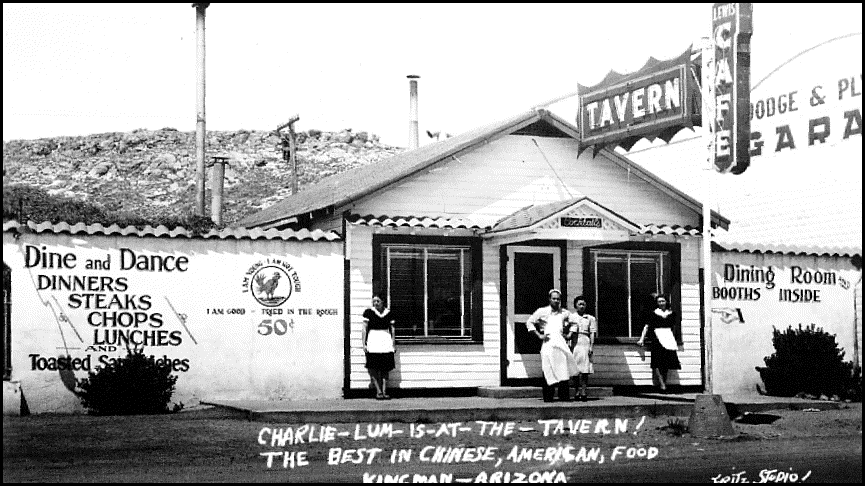put together reviews (and other items
in this magazine) that are not exactly indubitable.
It takes a while to catch on ---
a testy letter from a reader or a steamy letter
from a book's author may present us with the dreadful truth ---
but our stance is, as always,
once it sees the light of day, who are we to contest the fact
that now it may be seen as the Real McCoy?
And thus it stays.

Hummingbirds
Ronald Orenstein
(Firefly Books)The most minuscule of the species is the bee hummingbird, weighing in at .06 ounces, no larger than 2½ inches. The largest is the Patagona gigas of Chile, ten times larger than the bee. This "giant" hummingbird is nine inches long, and weighs as much as .8 oz, but, outside of sheer weight, it is a dull-bulb, a true bomb. Its coloration has been described by a leading ornothologist as "boring." Supporters of the giant hummingbird have banded together to taunt these experts, lambasting them with constant twitters and larding them with meager if insulting droppings.
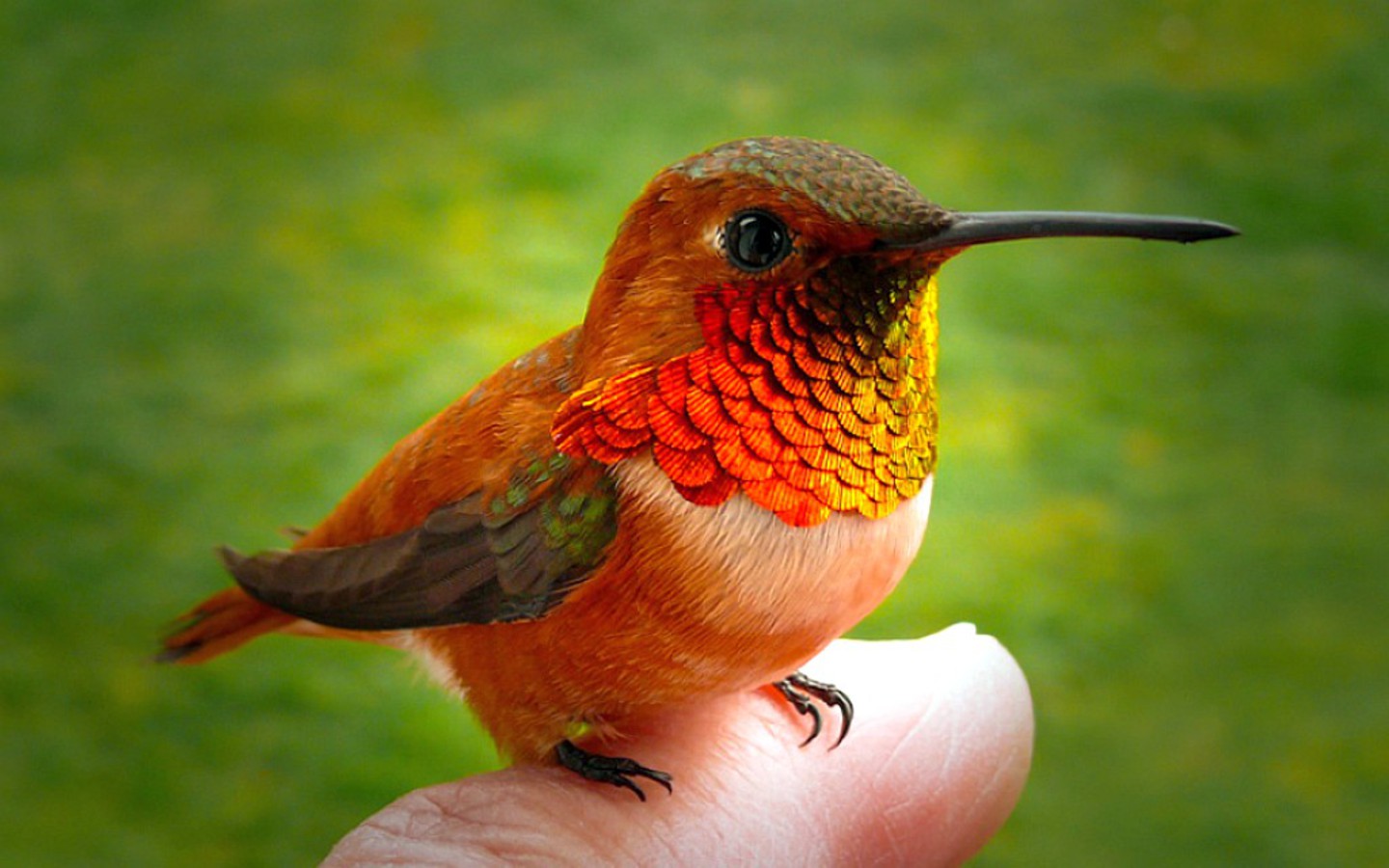
Still, there may be a brighter day for the patagona, because its days as the hummingbird gargantua may soon be over. This change has been brought about through studies of the common ruby-throat. Because of its extensive range, we've learned that it has to store up energy as fat . . . almost doubling its weight. This fact has led to the recent success of Japanese scientists to selectively produce ever-larger hummingbirds. By inbreeding, conjoined with Jack LaLanne-type exercise programs, ornithologists at Kobe University have recently created our first 65-pound hummingbird.Named Tubby the Terrible for his phenomenal girth (and miserable disposition), this fugitive from the gland gang can, unfortunately, no longer twitter, but merely groan. However, Tub uses his weight to get what he wants. When he spots another male hummingbird trying to pinch his poke, he sits on the sucker until he cries uncle.
Still, this bovine ruby-throat can barely fly, and has trouble moving about at all.
Go to the complete
reviewThe Lost King Of France
Revolution, Revenge, and the
Search for Louis XVII
Deborah Cadbury
(Fourth Estate)The French Revolution started when Louis XVI called up the Parlement because of a minor cash-flow problem, a shortfall of 72 billion gold francs. The Parlement responded by changing its name to the Real Estate Agents (The Estates-General). They met in the Salle des Menus Plaisirs (the Room of Pleasant Meals) and told Louis that if he would do something about Marie-Antoinette he could save a few ducats and possibly his head.Austria and France had just concluded a very long war, called the Seven Year's War even though it went on for nine years due to inflation. Wars lasted much longer in those days --- no nukes and missiles and smart-bombs, just muskets and pikestaffs --- and this one went on so long it caused the people to get cranky especially in August when it was time for everyone to leave Paris for les vacances in St. Tropez.Marie-Antoinette was from Austria, so she spoke French with a guttural accent, couldn't keep the king's books balanced (she was known as Madame Déficit) and took her good time in providing an heir. "Peuple" the People magazine of the day suggested that perhaps it was Louis XVI's fault. "His matchstiçk is always lîmp and curlèd up," they reported.Go to the complete
review
Fine Bonsai
Art & Nature
William N. Valavanis
Jonathan M. Singer, Photographer
(Abbeville Press Publishers)

Instead of being titled Fine Bonsai, it might well have been named Abusing Your Cedar. An artist by the name of Shen Shaomin has documented the brutalities inflicted on these inoffensive plants. Shaomin's on-line illustrations show the machinery by which these plants are forced into bizarre positions, shapes and configurations. "Wire cable, clamps, metal plates are used to 'torture' each bonsai tree into strange positions," he writes. His images athttp://www.designboom.com/art/shen-shaomin-bonsai-series/
are shocking: he shows twenty-two tiny instruments of torture (pliers, twisters, cages, splints, scrapers and points) that are used on a benign hinoki cypress, an innocent black pine, a gentle border privet, a shy juniper. Then there is an oriental photinia, an unassuming red-leaf hornbeam, a bashful trident maple, a frail japanese beautyberry, a quiet firethorn, a hoary hornbeam, a lonely Japanese snowbell cedar or black pine shown forced into confinement in a teeny pot with scarcely room for its crowded little roots ... constantly being jabbed and punched and trimmed and twisted, perhaps even being scolded when it tries to escape its dark little prison.
Go to the complete
reviewPier-Luigi Zucchini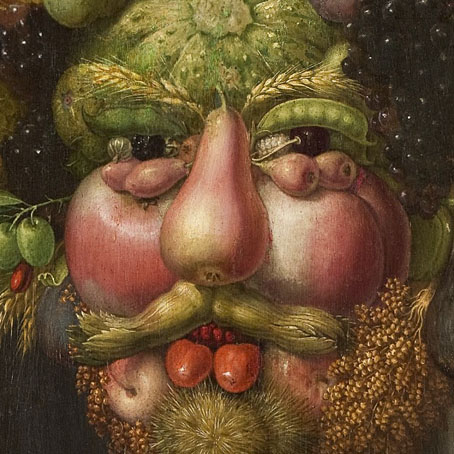 Among the many exciting finds in the revival of old music, none is more noteworthy than the rediscovery of the great Pier-Luigi Zucchini.
Among the many exciting finds in the revival of old music, none is more noteworthy than the rediscovery of the great Pier-Luigi Zucchini.Although widely acclaimed in his own time, Zucchini fell into disrepute during the late seventeenth century reaction against green vegetables, and remained virtually unknown throughout the later Baroque, or Pre-Cambrian period. Fortunately for music-lovers of our time, however, he was rediscovered lurking in our sales office several months ago.
Zucchini had a large green head and spike-y fingers, which earned him the sobriquet of "The Green Priest" in contemporary literature. Valdéz, for example, in his massive monograph Seventeenth Century Venice and the Pickle Barrel, refers to Zucchini as "a head above all others in the field --- and far tastier. Fry with butter, olive oil, and a little chives."
His "Pastrami Sonatæ," a series of seventeen thousand Cantatas for each feast day, were published between 1647 and the morning after. Many of these works have been lost, by sheer good fortune, but the fragments that remain mark Zucchini as a consummate master of the picayune. Scored for large forces (double choir, fat soloists, and military band obbligato) each work lasts no more than eleven seconds but seems much longer. The "Sonatæ" received several public performances, as a result of which Zucchini was deported.
Go to the complete
review
Owls
Cynthia Berger
(Stackpole)After reading Cynthia Berger's catalogue of the owl's eating and living habits, I think you'd be better off with a lemur or a platypus. Take your typical strigiformes diet. Gopher stew. Voles on toast. Lemming squash. Nuthatch fricassee. Duckling soup. Moth paste. Cats flambé. And, yuck, the common dung beetle.According to Ms. Berger, the Burrowing Owl goes about the prairie picking up "cowpies, horse manure, dog dirt, whatever" and "arranges the smelly treasures around the entrances to their burrows." They also line the inner walls of their little cellars with this crap.
Some nosy scientists thought they were dragging this foul mess home to fool their predators, who would leave off digging in and stealing their eggs because it all was so revolting. Not so. The Burrowing Owl has a vast appetite for dung beetles. Dung beetles go to, well, where the shit is. It's a drive-in restaurant for the owls, except instead of going through the golden arches to get a hamburger, the hamburger crawls up to your front door. In case you have a fondness for crunching beetles, this is an ideal arrangement.
Owls also are addicted to eating rats and mice. And they don't just tear them apart: When the Barn Owl catches a mouse, it "just swallows it head-first ... no dainty small bites."
Not only are their table-manners deplorable, their accommodations are vomit-inducing. The Screech Owl will typically have a nest filled up with various types of garbage. "The bottom of an owl's nest makes a nice home," says Ms. Berger, although we believe the word "nice" here should be considered relative. "It's a messy mulch of its own feces, coughed up owl pellets, and the remains of prey such as mice and beetles."
Ants and fly maggots move in to feed on this, so it becomes a stinkpot cafeteria. To make it even more vile, some owls bring home Texas blind snakes --- live ones --- who, once in the nest, defecate and release "a noxious, smelly liquid, then writhe so that the slippery mess coats their small bodies."
Go to the complete
reviewThe Lives of the Kings and
Queens of England
Antonia Fraser
Wanda McCaddon, Reader
(Audio Editions)Henry I was succeeded by Henry II, who "died from a surfeit of lampreys" which speaks volumes about English food. Henry II was succeeded by Henry III, Henry IV (Part 1) and finally Henry IV (Part 2).Meanwhile, the 1000 Years War had come to an end because the networks refused to renew for another season. In compensation, the Earl of Airwick, Edward IV and Henry VI decided to start the Wars of the Roses. In 1475, it was extended to France because the restaurants of Burgundy had challenged the restaurants of Armagnac over ratings of vaut le voyage in the Guide Michelin. All was resolved ten years later when Henry came to town in a Tudor sedan and had a blowout at Tewkesbury.
Eventually, the Black Death reduced the population of Britain which led to an economic upturn. With the revival of commerce in the 1400s, the English captured the continental market in nappies and woolies. In exchange, French wine and German BMWs were imported into Britain and the Italians invented banking, insurance, and double-entry bookkeeping (familiarly known as antipasto).
Trade with Asia also resumed, permitting the merchants of Venice to bring controlled substances to land at Venice Beach. In time, these were distributed over all of Europe, bringing on the High Middle Ages. Art flourished, Henry VIII's wives quite lost their heads, which inspired the following Early Renaissance Glee:
Poor Ann Boleyn was once King Henry's wife ---
Until he made the Headsman bob her hair!
Ah yes! he did her wrong long years ago,
And she comes up at night to tell him so.Go to the complete
reviewWoodpeckers of the World
A Photographic Guide
Gerard Gorman
(Firefly)We have to report that there is now a move by animal rights group to change the habits of endangered woodpeckers . . . though not endangered by deforestation or human activity, however.According to PETA, the thought is that by continually seeking bugs and larvæ in hidden places, these little Picidæ are, in effect, driving themselves bonkers, damaging their tiny bird-brains with their continual drumming on trees, stumps, power-line supports and posts, all in the pursuit of the evening hors d'oeuvre.
PETA is thus seeking volunteers to encourage our little friends to seek other sites for sustenance . . . has even hired behaviorist scientists to try to train these bird-brains to utilize, for example, feeders set out by hummingbird lovers around the world; to convert the woodpeckers from grisly grubs and worms to seeds and sweets . . . ultimately going meatless (as most PETA members are).
One North American branch is paying professional ornithologists and avian specialists --- specialists, that is, in the evolutionary change of passerines --- to begin to alter the very shape of their beaks. The thought is that if we bred out those sharp upper and lower mandibles, our feathered friends could begin to evolve away from bad habits like constantly bashing their little beaks against dense trees, painful exercises that can ultimately drive them potty.
These Friends of the Woodpecker have created a procedure of retrofitting the birds with flexible plastic bills so they can seek nourishment in the many bird-feeders set out by bird-lovers.
We do not yet know the full impact of this, but the fact is that such changes would help to enforce the many differences represented here in this excellent study, pictures of 239 Piciformes worldwide . . . now to be saved from total battiness, a divine present for our children and children's children stretching into the far future.
Go to the complete
reviewCarl Heinrich Graun
A Candleflame on
The Tavern WallChristolf Wolff, in his gigantic tome on Bach, includes a diagram from 1800, the "sun of composers." In the center is Bach. Around him, three rays: Franz Joseph Haydn, George Friederick Handel, and Carl Heinrich Graun. Graun? Who Graun? Are we missing something?Carl Heinrich Graun was one of those artists, like Per Luigi Zucchini or my uncle Sid, whose fame flickered all too briefly, a candleflame on the tavern wall. A boon companion of King Frederick the Great of Prussia, Graun celebrated the king's conquest of Upper and Lower Silesia with the first Ode to Joy --- Joy Maedelbachen Graun being his Graunmother. In return, Frederick wrote the story-board for Graun's celebrated, autobiographical operas Lohengraun and Das Rheingraun. They were produced in off-Berlin but flopped so badly that they were moved to off-off-Baden-Baden.
Here the composer's fortune improved. The city of Baden-Baden had just been overrun by rats, which packed the streets, took over the gutters, ate up the sidewalks, and refused to get out of the bierstuben. But the rodents were so enchanted by Graun's music that they flocked to the opera house to hear his new song cycle Die Liederhosenlaudenflauffen, BMW 240. The rodents were rendered quiescent by the music, so that the city building department was able to squash them with a steam roller. The composer immediately memorialized the great day in his new opera, Die Flattermaus, which was a popular success with the townspeople. The critics compared Graun to the greatest masters and the grateful city of Baden-Baden appointed him Kapellkapellmeister-meister. It was during this time that he produced his greatest secular Cantata, Ich bin ein Doppelgänger, BVD 36-long.
After this triumph, Graun produced a symphony of some note (possibly E-flat, although it is hard to be sure), the moving Theme and Variations on 'Graun Grow the Grässes-Oh?' and a cycle of quartets. Unfortunately, his balance was not what it had been and he fell off the cycle going around a corner and had to switch to a tricycle. Next, he began his famous experiments in edible counterpoint, which he illustrated in his Tafelmusik, BFD 7-11, for various ensembles of coldcuts. Works included the Openface Sonata for pastrami and headcheese, a set of trio sonatas with basso continuo and potato salad on the side, and the merry Sauerkraut Dances. These too were a great success with his public, which ate them up.
In his Golden Years, Graun dropped music entirely to work on developing new foods for senior citizens. His crowning achievement was the cereal Graunola, the popularity of which keeps his name alive today. If you ever visit Baden-Baden, you will find a statue of Graun in the Rathausplatz, with a band of rodents (after whom the square is named) dancing happily about, nipping at his toesies.
Birds of San Diego
Chris Fisher,
Herbert Clarke
(Lone Pine)Some of us are not very good at bird-watching. We tend to confuse bumblebees with Rufous Hummingbirds, and get excited when we see a Rock Dove which --- the authors inform us --- is the common street pigeon. For us (and our myopia, and our astigmatism) the Western Gull could just as well be the Loggerhead Shrike or the Bufflehead. God knows, we couldn't differentiate between Brewer's Blackbird and the Brown-Headed Cowbird, much less a Bushtit (or, for that matter, bird shit).
Anyway, Birds of San Diego is a misnomer...
there are damn near no birds left in the area. The reason, according to a recent Los Angeles Times article, can be laid at the door, or on the plate, of the common house cat. Each domestic cat --- even well-fed ones --- will capture and consume over a hundred birds a year. The feral ones do much worse. With the feline population of southern California reaching 50,000,000 and growing steadily, we would guess the time will soon be upon us when the trees will be bare, except for garage-sale signs, and the only bird songs we'll hear will be the shriek of the alarm on the neighbor's car as its being rifled at midnight.
Go to the complete
reviewArizona
A Celebration of
The Grand Canyon State
Jim Turner
(Gibbs Smith)Arizona is called "A Celebration," but it would better be known as "hernia-inducing." Drop it on your toe and you're a goner. It contains over three hundred pages of heavy paper stock with hundreds of photographs and a text that strives valiantly to paint a grobian culture as one that deserves our loyalty if not love.
But rather than seeing it as a monument to a state filled with plutocrats and ninnies, we could better see it as a repository of collective amnesia. And for those of us who treasure photographs from the deep past, it is a book whose pages might be subject to a bowie knife: so you can hang these exquisite pictures on your wall.
Finally, all Americans must acknowledge the terrible mistake we made in 1912, when we admitted Arizona, the last of the original forty-eight states to the union. Let us confess now, in all honesty, that this is something that would have better been left undone. There is one hope, however. That is the chance that its original owner, from before 1848, will allow us to return the whole state, postage due. God knows if they are willing to accept, but, for our national sanity as well as future national peace-of-mind, it is a step we must take ... if it's not already too late.
Go to the complete
reviewThe Little Ice Age
How Climate Made History
<Brian Fagan
(Basic Books)The Little Ice Age suffers from a pedestrian style of writing, possibly because Professor Fagan lives near a pedestrian area in Santa Barbara, California. This means he is as far as possible from the freezing mistrals and impossible pronunciations of placenames in Greenland like Uummannaq, Qaanaaq and Nuuk. We found ourselves drifting off into dreamland with descriptions of yet another storm sweeping in "on November 26-27, 1703, where a low pressure system with a center of 950 millibars passed about 200 kilometers north of London."However, it isn't all Sturm und Drang out there in Medieval and Renaissance-vile. Fagan manages to spark some interest with his occasional asides, claiming, for instance, that the "golden years" of cathedral building --- Notre Dame, Rheims, Canterbury Cathedral, Lincoln, the Sainte-Chapelle in Paris and the Crystal Cathedral of Burbank --- were a result of a Medieval Warm Period of unparalleled prosperity and an abundance of toaster ovens. He also suggests that large storms of the 16th century where "crops failed and cattle perished by diseases caused by abnormal weather" caused some of the Delft Valley Girls to be dubbed witches with the result that they were rotisseried for their sins.
Professor Fagan even hints that the French Revolution came about because of the "bitterly cold winter of 1788/1789," where "heavy snowfall blocked roads, major rivers froze over, and much commerce came to a standstill." However, he leaves it to the reader to imagine the details of this climatic determinism. This reviewer has a picture of a Paris mob storming the Bastille because of ice in their vichysoise, and Robespierre's chilly smile becoming even chillier when he couldn't start his Deux Cheveux in the morning.
Go to the complete
reviewEskimo
Architecture
Dwelling and Structure in
The Early Historic Period
Molly Lee
Gregory A. Reinhardt
(University of
Alaska Press)
